Pink. It's not just a color. It's a reminder.
Early detection saves lives! Nor-Cal Think Pink reminds you to follow these guidelines for Breast Cancer Detection:
Age 20-39
- Every month: Perform a breast self-exam.
- Every 3 years: Have a clinical breast exam by a doctor or nurse.
- See your doctor for your annual well-woman check-up and clinical breast exam.
- Are you high risk? Know your family history!
- Live healthy lifestyle.
- Most Importantly: Trust your instincts. Take control of your body. Be proactive. DON’T WAIT!
Age 40+
- Every month: Perform a breast self-exam.
- Every year: Have a mammogram and a clinical breast exam by a doctor.
- See your doctor for your annual well-woman check-up and clinical breast exam.
- Are you high risk? Know your family history!
- Live healthy lifestyle.
- Most Importantly: Trust your instincts. Take control of your body. Be proactive. DON’T WAIT!
Be Breast Aware. Know the Symptoms of Breast Cancer
- Swelling, soreness, or rash
- Nipple discharge
- Change in size and/or shape
- Dimpling or puckering
- Itchy, scaly sore or rash around the nipple
- Nipple that becomes flat or inverted
- Know “YOUR NORMAL” and your body by doing a breast self-exam at the same time each month.
Steps to Early Detection
Nor-Cal Think Pink recommends:
- Yearly mammograms starting at age 40 and continuing for as long as a woman is in good health.
- Clinical breast exams (CBE) should be part of a periodic health exam, about every three years for women in their 20s and 30s and every year for women 40 and over.
- Women should know how their breasts normally feel and report any breast change promptly to their health care providers. Breast self-exam (BSE) is an option for women starting in their 20s.
- Women at high risk (greater than 20% lifetime risk) should get an MRI and a mammogram every year. Women at moderately increased risk (15% to 20% lifetime risk) should talk with their doctors about the benefits and limitations of adding MRI screening to their yearly mammogram. Yearly MRI screening is not recommended for women whose lifetime risk of breast cancer is less than 15%.
- For more information, visit the National Cancer Institute.
How to do a Breast Self-Exam
Because we care,
We Recommend Monthly Breast Self-Exams (BSE)
DO THE EXAM AT THE SAME TIME OF THE MONTH EVERY MONTH!
1. Basic BSE Method
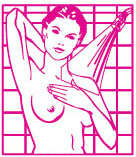
1. Do exam while in the shower or while lying flat on your back:
- Raise arm overhead with hand behind your head of the breast you are examining.
- Use other hand to examine breast using first 3 finger pads only.

2. Use gentle pressure using three different levels:
- Level one: Soft pressure to feel tissue closest to skin.
- Level two: Medium pressure a little deeper.
- Level three: Firm pressure to feel chest and ribs.
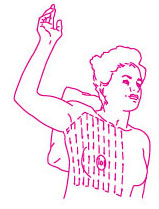
3. Move over breast in an up and down pattern (like moving a yard).
- Leave fingers on breast and move up and down the breast lifting the outer finger to move the other two fingers to a new spot.
- Do not miss any portion of the breast.
2. Patterns of Search
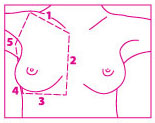
Move over the breast in an up and down pattern, see diagram to left.
1. Feel to the collar bone (clavicle), Fig. 1.
2. Feel to the middle of the chest (sternum), Fig. 2
3. Feel to the bottom of the breast, Fig. 3
4. Feel to the edge of the breast and under arm pit (axilla), Fig. 4
5. Feel the upper arm above arm pit to bottom of the collar bone (clavicle bone), Fig. 5
A firm ridge in the lower curve of each breast is normal (distal edge of clavicle).
3. Standing Before a Mirror:
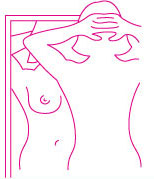
1. Place arms at sides, then place hands on hips pressing firmly down on your hips, followed by arms over your head. Finish by lifting breast and checking skin under the breast.
2. Check for any changes in size, shape, contour dimpling, pulling, redness, dryness of the nipple or the breast skin.
4. Examine the Underarm (axilla):
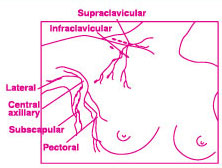
1. Examine each underarm while sitting or standing for any lumps. Lymph nodes that are persistent and are usually firm need to be examined by a practitioner.
2. Have arm slightly raised to easily feel the area.
3. Follow diagram checking under the arm and above the collar bone.